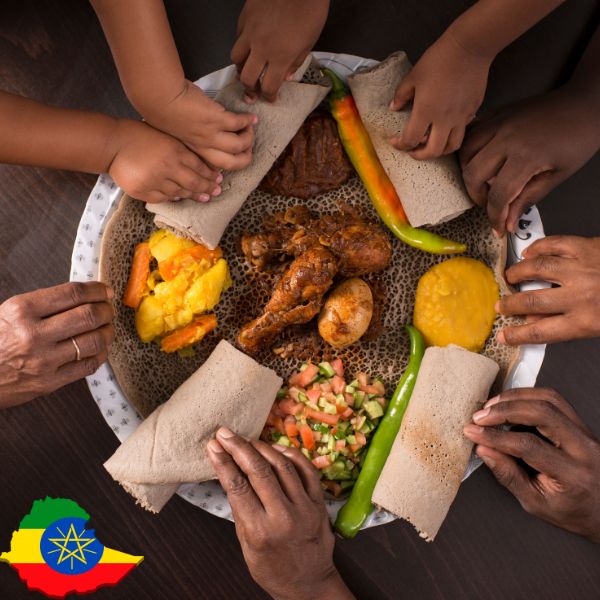Last updated on August 17th, 2025 at 07:26 am
Shakshuka eggs, a versatile and vibrant dish from the Middle East and North Africa, have become a beloved staple in Israeli cuisine. It’s more than just a meal; it celebrates flavors, traditions, and adaptability. Traditionally prepared with eggs poached in a rich, spiced tomato sauce, shakshuka’s popularity has inspired many variations to suit diverse palates and dietary needs.
Below, we explore the many creative takes on shakshuka, showcasing how this dish has evolved to incorporate various ingredients while retaining its essence.
Classic Shakshuka Eggs
The traditional version of shakshuka features eggs gently cooked in a sauce made from ripe tomatoes, onions, garlic, and spices like cumin and paprika. This comforting dish is often served with crusty bread to soak up the flavorful sauce, making it a satisfying option for breakfast, lunch, or dinner.
Green Shakshuka – Healthy green shakshuka recipe with za’atar
A verdant twist on tradition.
Green shakshuka replaces the usual tomato base with leafy greens like spinach, Swiss chard, and kale. Fresh herbs, such as cilantro, parsley, and dill, add brightness, while vegetables like green peppers and zucchini provide texture.
This version is often seasoned with za’atar, a Middle Eastern spice blend, and served with a dollop of yogurt or sour cream for added creaminess. Its vibrant color and fresh flavors make it a standout choice for brunch or a light dinner.
Mushroom Shakshuka – recipe with creamy tomato sauce
Earthy flavors for mushroom lovers.
This variation combines a rich mix of mushrooms, such as button, cremini, or shiitake, with the traditional tomato base. Sautéed mushrooms add a deep, umami flavor, and some recipes include a splash of white wine or cream for extra richness. The result is a hearty, satisfying dish that pairs beautifully with crusty bread or pita.
Vegan Shakshuka – With tofu and vegetables
A plant-based delight.
As veganism continues to gain popularity, chefs have taken on the challenge of creating a vegan shakshuka. In vegan versions, additional vegetables, such as bell peppers, eggplant, or zucchini, take center stage. Beans or tofu often replace eggs to maintain the dish’s protein content. Seasoned with bold spices and served with vegan bread, this variation ensures that no one misses out on the comforting flavors of shakshuka.
Shakshuka with Feta – Recipe with feta cheese and fresh herbs
It’s a tangy Mediterranean twist.
Adding crumbled feta cheese to the classic tomato shakshuka enhances its flavor profile with a creamy, tangy kick. The feta melts slightly into the warm tomato sauce, creating a luxurious texture. It’s a perfect brunch dish, often garnished with fresh herbs and served with toasted bread.
Chraime Shakshuka – With poached fish recipe
A spicy seafood-inspired shakshuka.
Chraime, a North African fish dish, influences this shakshuka variation by incorporating fish, such as cod or hake, into the spicy tomato sauce alongside the eggs. Spices like caraway, cumin, and hot chili add bold flavors, making this dish a favorite for those who love spicy and savory combinations.
Sausage Shakshuka Eggs – Sausage shakshuka with chorizo and eggs
It’s a hearty and smoky variation.
Spicy sausages, such as merguez (a North African lamb sausage) or chorizo, elevate shakshuka with their smoky, meaty depth. The sausages are cooked in the tomato sauce before being added to the eggs, allowing their flavors to infuse the entire dish. This hearty version is perfect for a weekend breakfast or a comforting dinner.
Yemenite Shakshuka – Recipe with hawaij spices
A spice-infused delight.
Inspired by Yemenite Jewish cuisine, this shakshuka variation incorporates hawaij, a fragrant spice blend of turmeric, cumin, coriander, and black pepper. The spices give the dish a warm, golden hue and a uniquely complex flavor. Often paired with flatbread or challah, Yemenite shakshuka is a flavorful tribute to its cultural roots.
Curried Coconut Lentil Shakshuka
A fusion of global flavors.
This creative shakshuka variation combines lentils, coconut milk, and curry spices for a hearty and exotic dish. The lentils add texture and protein, while the coconut milk gives it a creamy, indulgent finish. It’s a fantastic option for a vegetarian or vegan-friendly meal with bold, flavorful dishes.
Shakshuka with Spiced Beef Breakfast Sausage
A protein-packed start to the day.
This shakshuka features spiced beef sausage, which adds a robust, savory flavor. The sausages are crumbled and cooked with the tomato base, blending their spices into the sauce. It’s a protein-packed breakfast option that’s both satisfying and flavorful.
| Variant | Base | Signature Ingredients | Spices & Herbs | Flavor Profile | Typical Time | Diet Notes | Great Toppings / Sides |
|---|---|---|---|---|---|---|---|
| Shakshuka Eggs (Classic) | Tomato–pepper sauce | Eggs, onion, garlic, crushed tomatoes, bell pepper | Cumin, sweet paprika, chili flakes, parsley/cilantro | Tangy, savory, gently spicy | 20–30 min | Vegetarian; protein from eggs | Feta, olives, fresh herbs; pita or sourdough |
| Shakshuka Green | Leafy greens & herbs | Spinach/chard/kale, leeks, zucchini, eggs or feta | Cumin, coriander, garlic, lemon zest, green chili | Fresh, herbal, bright | 20–25 min | Vegetarian; lighter, iron- and fiber-rich | Yogurt dollop, avocado, herbs; warm flatbread |
| Shakshuka Eggplant | Tomato base with roasted eggplant | Eggplant cubes, tomatoes, onions, peppers, eggs | Smoked paprika, cumin, garlic, oregano | Hearty, silky, slightly smoky | 30–40 min | Vegetarian; extra fiber & potassium | Labneh or tahini, parsley; crusty bread |
Shakshuka is a flexible one-pan meal with three tasty paths: shakshuka eggs, shakshuka green, and shakshuka eggplant. For classic shakshuka eggs, a well-seasoned shakshuka pan is warmed with olive oil, garlic, onions, and tomatoes until saucy, then gently poaches eggs on top. The result is rich, tangy, and perfect for crusty bread.
Shakshuka green swaps tomatoes for leafy greens and herbs. In a hot skillet, sauté leeks, spinach, basil, and a small amount of zucchini, then stir in cumin, coriander, and lemon zest. Crack in eggs or add feta for protein. The flavor is bright, fresh, and wonderfully aromatic.
Shakshuka eggplant is heartier. Roast or pan-sear cubes of eggplant until golden, then simmer with tomatoes, peppers, and smoked paprika. Finally, nestle the eggs to finish. The sauce becomes silky and slightly smoky.
Whichever style you choose, the right shakshuka pan is essential: it should be heavy, oven-safe, and wide enough to hold the sauce in a shallow layer. Serve with warm pita or sourdough, plus herbs and a drizzle of olive oil. These variations are perfect for weeknights, budget-conscious, and great for sharing. It’s ideal for breakfast, brunch, or a light dinner, with easy clean-up and customizable heat levels. Kids love it.
Vegan and Vegetarian Shakshuka Ideas
With its rich, spiced tomato base, Shakshuka is a naturally adaptable dish that caters wonderfully to vegan and vegetarian diets. By swapping or omitting certain ingredients, you can create flavorful versions of this classic dish without compromising taste or texture. Below are some creative vegan and vegetarian shakshuka ideas that will delight plant-based eaters and anyone looking to explore meatless options.
Classic Vegetarian Shakshuka Eggs
This variation remains true to the traditional shakshuka recipe, utilizing eggs as the primary protein source. The rich tomato base, flavored with garlic, onions, paprika, and cumin, is the perfect backdrop for poached eggs. Add a sprinkle of fresh parsley and a slice of crusty bread to complete this comforting meal.
Pro Tip: Top with a dollop of sour cream or sprinkle of feta cheese for added creaminess.
Vegan Shakshuka with Tofu “Eggs”
For a vegan twist, tofu can be an excellent substitute for eggs. Firm or silken tofu seasoned with turmeric and nutritional yeast mimics the color and texture of eggs. Crumble it into the tomato sauce or shape it into rounds for a more traditional appearance.
Flavor Boost: Add bell peppers, zucchini, and spinach to increase the vegetable content and enhance the dish’s nutritional value.
Lentil-Based Vegan Shakshuka
Lentils are a fantastic addition to shakshuka for added protein and texture. Combine cooked lentils with the tomato sauce and top with a garnish of fresh herbs. This hearty version is perfect for a filling brunch or dinner.
Pairing Suggestion: Serve with warm pita bread or vegan naan for scooping up the rich sauce.
Coconut Cream Vegan Shakshuka
For a creamy and indulgent vegan option, stir coconut cream or coconut milk into the tomato base. This adds a luscious texture and a hint of sweetness that pairs beautifully with the spices. Garnish with fresh cilantro and serve with rice or flatbread.
Roasted Vegetable Shakshuka
Elevate your shakshuka by roasting vegetables like eggplant, cherry tomatoes, and sweet potatoes before adding them to the tomato base. This version offers a smoky, caramelized flavor and works well for meal prep or entertaining.
Topping Idea: Drizzle with tahini for a nutty, creamy contrast.
Vegan Protein Shakshuka
Include plant-based proteins like chickpeas or tempeh to make a high-protein vegan shakshuka. Chickpeas absorb the flavors of the sauce, while tempeh adds a slightly nutty texture.
Serving Idea: Enjoy this version over quinoa or couscous for a complete meal.
Traditional vs. Modern Recipes
Shakshuka eggs have been enjoyed for generations, evolving from their traditional roots in the Middle East and North Africa to a globally loved dish with endless modern interpretations. Let’s explore the distinctions and innovations between the classic and contemporary approaches to shakshuka.
Traditional Shakshuka Eggs
- Ingredients: Traditional shakshuka eggs are made with simple, accessible ingredients: tomatoes, onions, garlic, olive oil, eggs, and spices such as cumin, paprika, and chili. The dish is rustic and hearty, relying on slow cooking to develop its robust flavor.
- Cooking Style: Traditionally, shakshuka eggs are cooked in one skillet, allowing the eggs to poach directly in the bubbling tomato sauce. This method ensures a beautifully layered flavor and a comforting homestyle presentation.
- Serving: Traditional shakshuka, often enjoyed with pita or flatbread, is a staple breakfast or dinner in many households. It is paired with simple sides, such as olives or a fresh salad.
Modern Shakshuka Recipes
Modern shakshuka recipes experiment with ingredients, techniques, and presentations to cater to diverse tastes and dietary needs. Here’s how they differ:
Ingredient Variations:
Contemporary shakshuka recipes often incorporate various additions, including green vegetables, exotic spices, or proteins like fish or sausage. Ingredients such as feta cheese, vegan substitutes, and coconut milk add creative new dimensions to the dish.Dietary Adaptations:
Modern shakshuka is highly inclusive of dietary preferences. Vegan versions replace eggs with tofu or legumes, while keto-friendly recipes reduce carb content by using a base of greens instead of grains or starchy vegetables.Global Flavors:
Modern interpretations incorporate flavors from different cuisines. For example, curry spices and lentils give shakshuka an Indian-inspired twist, while coconut milk and Thai basil lend a Southeast Asian flair.Serving Styles:
Unlike the traditional one-pan approach, modern shakshuka can be baked in individual ramekins or served over grains like quinoa or couscous, making it a complete meal. This approach often appeals to a more refined, restaurant-style presentation.
- Are You Excited Of The Magic Of Filipino Food?
- Japanese Cuisine: A Great Feast of Colors and New Flavors
- The Faith and Incredible Ethiopian Coffee Ceremony: Love It!!
- Vietnamese Cuisine: Exciting New Flavors and Happy Trends








